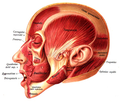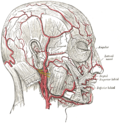Levator labii superioris
Levator labii superioris is a muscle in the human face that elevates the upper lip, aiding in facial expressions like surprise or disgust. It is one of the muscles involved in the facial expression system, and is controlled by the facial nerve.
Anatomy[edit]
The levator labii superioris originates from the infraorbital margin of the maxilla, just below the infraorbital foramen. It inserts into the skin of the upper lip, blending with the muscles of the area. It is a broad, flat muscle, and is sometimes divided into two parts: a medial part, which is also known as the levator labii superioris alaeque nasi, and a lateral part.
Function[edit]
The primary function of the levator labii superioris is to elevate the upper lip, which contributes to facial expressions such as surprise, disgust, and sadness. It also assists in deepening the nasolabial furrow during these expressions. In addition to these functions, the muscle also helps in the process of eating and speaking.
Clinical significance[edit]
Damage to the levator labii superioris can result in a decreased ability to move the upper lip, which can affect facial expressions, speech, and eating. This can occur due to trauma, surgery, or neurological conditions that affect the facial nerve. Treatment typically involves physical therapy to restore function, and in some cases, surgery may be required.
See also[edit]
-
Levator labii superioris
-
Levator labii superioris
-
Levator labii superioris
-
Levator labii superioris
-
Levator labii superioris
-
Levator labii superioris
Ad. Transform your life with W8MD's Budget GLP-1 injections from $75


W8MD offers a medical weight loss program to lose weight in Philadelphia. Our physician-supervised medical weight loss provides:
- Weight loss injections in NYC (generic and brand names):
- Zepbound / Mounjaro, Wegovy / Ozempic, Saxenda
- Most insurances accepted or discounted self-pay rates. We will obtain insurance prior authorizations if needed.
- Generic GLP1 weight loss injections from $75 for the starting dose.
- Also offer prescription weight loss medications including Phentermine, Qsymia, Diethylpropion, Contrave etc.
NYC weight loss doctor appointmentsNYC weight loss doctor appointments
Start your NYC weight loss journey today at our NYC medical weight loss and Philadelphia medical weight loss clinics.
- Call 718-946-5500 to lose weight in NYC or for medical weight loss in Philadelphia 215-676-2334.
- Tags:NYC medical weight loss, Philadelphia lose weight Zepbound NYC, Budget GLP1 weight loss injections, Wegovy Philadelphia, Wegovy NYC, Philadelphia medical weight loss, Brookly weight loss and Wegovy NYC
|
WikiMD's Wellness Encyclopedia |
| Let Food Be Thy Medicine Medicine Thy Food - Hippocrates |
Medical Disclaimer: WikiMD is not a substitute for professional medical advice. The information on WikiMD is provided as an information resource only, may be incorrect, outdated or misleading, and is not to be used or relied on for any diagnostic or treatment purposes. Please consult your health care provider before making any healthcare decisions or for guidance about a specific medical condition. WikiMD expressly disclaims responsibility, and shall have no liability, for any damages, loss, injury, or liability whatsoever suffered as a result of your reliance on the information contained in this site. By visiting this site you agree to the foregoing terms and conditions, which may from time to time be changed or supplemented by WikiMD. If you do not agree to the foregoing terms and conditions, you should not enter or use this site. See full disclaimer.
Credits:Most images are courtesy of Wikimedia commons, and templates, categories Wikipedia, licensed under CC BY SA or similar.
Translate this page: - East Asian
中文,
日本,
한국어,
South Asian
हिन्दी,
தமிழ்,
తెలుగు,
Urdu,
ಕನ್ನಡ,
Southeast Asian
Indonesian,
Vietnamese,
Thai,
မြန်မာဘာသာ,
বাংলা
European
español,
Deutsch,
français,
Greek,
português do Brasil,
polski,
română,
русский,
Nederlands,
norsk,
svenska,
suomi,
Italian
Middle Eastern & African
عربى,
Turkish,
Persian,
Hebrew,
Afrikaans,
isiZulu,
Kiswahili,
Other
Bulgarian,
Hungarian,
Czech,
Swedish,
മലയാളം,
मराठी,
ਪੰਜਾਬੀ,
ગુજરાતી,
Portuguese,
Ukrainian






